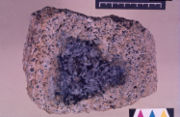Bauxite Ore

 |
| Bauxite with a US Cent |
 |
| Bauxite with core of unweathered rock |
|
|
Bauxite is the most important aluminium ore. It consists largely of the minerals gibbsite Al(OH)3,
boehmite γ-AlO(OH), and diaspore α-AlO(OH), together with the iron oxides goethite and hematite,
the clay mineral kaolinite and small amounts of anatase TiO2. It was named after the village Les
Baux-de-Provence in southern France, where it was first discovered in 1821 by geologist Pierre Berthier.
Bauxite information
Lateritic bauxites
(silicate bauxites) are distinguished from karst bauxites (carbonate bauxites). The early discovered
carbonate bauxites occur predominantly in Europe and Jamaica above carbonate rocks (limestone and dolomite),
where they were formed by lateritic weathering and residual accumulation of intercalated clays or of
clayey dissolution residues of the limestone.
The lateritic bauxites occur in many countries of the tropical belt.
They were formed by lateritization of various silicate rocks such as granite,
gneiss, basalt, syenite and shale. Compared with iron-rich laterites, the formation of bauxites
demands even more intense weathering conditions with a very good drainage. This enables dissolution
of kaolinite and precipitation of gibbsite. Zones with highest aluminium content are frequently
located below a ferruginous surface layer. The aluminium hydroxide in the lateritic bauxite deposits
is almost exclusively gibbsite.
Production trends
In 2007,
Australia was the top producer of bauxite with almost one-third world share,
followed by China, Brazil, Guinea and Jamaica. Although aluminum demand is rapidly increasing,
known reserves are sufficient to meet the needs for a considerable time. Increased aluminum recycling,
which has the advantage of lowering the energy costs of production, will help extend Bauxite reserves.
| (in '000 tonne, Numbers for 2007 estimated) |
| Country | 2006 | 2007 | Reserves | Reserve base |
| Australia | 62,300 | 64,000 | 5,800,000 | 7,900,000 |
| China | 21,000 | 32,000 | 700,000 | 2,300,000 |
| Brazil | 21,000 | 24,000 | 1,900,000 | 2,500,000 |
| Guinea | 14,500 | 14,000 | 7,400,000 | 8,600,000 |
| Jamaica | 14,900 | 14,000 | 2,000,000 | 2,500,000 |
| India | 12,700 | 13,000 | 770,000 | 1,400,000 |
| Russia | 6,600 | 6,000 | 200,000 | 250,000 |
| Venezuela | 5,500 | 5,500 | 320,000 | 350,000 |
| Suriname | 4,920 | 5,000 | 580,000 | 600,000 |
| Kazakhstan | 4,800 | 4,900 | 360,000 | 450,000 |
| Greece | 2,450 | 2,400 | 600,000 | 650,000 |
| Other countries | 5,460 | 6,800 | 3,400,000 | 4,000,000 |
| World total (rounded) | 178,000 | 190,000 | 25,000,000 | 32,000,000 |
| Source: U.S. Geological Survey, Mineral Commodity Summaries, January 2008 |
Processing
Bauxite
is strip mined (surface mining) because it is found at the surface, with little or no overburden.
Approximately 95% of the world's bauxite production is processed into aluminium. Bauxites are typically
classified according to their intended commercial application: metallurgical, abrasive, cement, chemical and
refractory.
Bauxites are heated in pressure vessels with sodium hydroxide solution at 150-200 °C through
which aluminium is dissolved as aluminate (Bayer process). After separation of ferruginous
residue (red mud) by filtering, pure gibbsite is precipitated when the liquor is cooled and seeded
with fine grained aluminium hydroxide. Gibbsite is converted into aluminium oxide by heating.
This is molten at approx. 1000 °C by addition of cryolite as a flux and reduced to metallic
aluminium by a highly energy-consumptive electrolytic process (the Hall-Héroult process).